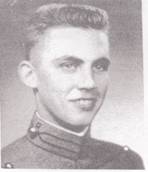Courtesy of the United States Military Academy
Owen S. Nibley
NO. 17716
30 January 1928 – 10 May 1982
Died in Bethesda, Maryland
Interred in Arlington National Cemetery
Owen Smoot Nibley was born and raised in Washington, D.C. His mother was the daughter of the first senator from Utah, Reed Smoot, and her father was also a native of Utah. Owen was named after a relative, but his mother nicknamed him “Pete”, which was how he would forever be known.
As a youth, Pete spent summers in rural Virginia raising hunting dogs. He also earned many badges and honors as an Eagle Scout. It was in the fifth grade that he met his future wife, Frances Elizabeth “Betty” Browder. In 1941, however, Betty moved with her family to Honolulu, where her father, a Naval Officer, had been transferred. Pete and Betty would not see each other again until Christmas, 1949. Pete meanwhile continued his education, graduating in 1946 from Columbia Preparatory School in Washington. He obtained an appointment to West Point from Senator Thomas of Utah and entered the Academy in 1946 as a member of the Class
of 1950.
During his cadet days, Pete was well-liked for his keen wit and his easygoing manner. His extracurricular activities included fencing, membership in the Skeet and Fishing Clubs, and serving on the Howitzer and Pointer staffs.
Upon graduation, Pete was commissioned in the Air Force. Before reporting for primary flight training at Perrin Air Force Base, Texas, he married Betty on 2 August 1950. In 1951, the Nibleys were off to Craig Air Force Base in Selma, Alabama, for advanced flight training. There, their first son, Andrew Matthews, was born. Pete completed that training and was awarded the silver wings of an Air Force pilot. After gunnery school in 1952, he departed for Korea to join the 18th Fighter Bomber Wing. He flew 70 combat sorties in the P-51 Mustang and was awarded the Distinguished Flying Cross and the Air Medal with an oak leaf cluster. During one sortie, he experienced a near catastrophic mishap. His aircraft caught fire on take off, but Pete managed to belly land on a sandbar in a dry riverbed without suffering injury. During another sortie, his canopy was shot off. With help from his wingman, Pete brought the aircraft back to base safely. He was awarded the Purple Heart for the wound he received on that mission.
In 1952, Pete returned to the States to fly support missions for ground control teams and taught in the All-Weather Interceptor Program at Tyndall Air Force Base, Florida. At Tyndall, two more sons were born. Stuart Browder in 1953 and Peter Smoot in 1956. The Nibley family moved to Arlington, Virginia, in 1958, for Pete to earn a Master’s Degree in International relations at George Washington University. In 1958, the Family moved to Colorado Springs, Colorado, where Pete joined the Political Science Department of the newly-established Air Force Academy. Pete also flew training missions for cadets undergoing navigation training, and was proud to be a member of the faculty when the first class graduated in 1959.
In 1962, Pete pursued a Master’s Degree in electrical engineering at the University of Illinois. Two years later, after receiving that degree, the family moved to the DC area, where Pete served on the Air Staff in the Office of the Director of Plans at the Pentagon. He also earned his command pilot wings.
As the conflict in Viet Nam heated up, Pete decided to volunteer for combat duty there. In 1967, Pete trained to fly C123’s at Hurlburt Field near Eglin Air Force Base and left for Viet Nam in August 1967 to join the 311th Air Commando Squadron. Unfortunately, that tour was curtailed because of his medical problems. In January 1968, he underwent treatment at the hospital at Wright-Patterson Air Froce Base, Ohio. Pete retired from active duty in May 1968 as a lieutenant colonel with 100 percent disability.
Pete received a second oak leaf cluster to the Air Medal for his service in Viet Nam. His other military awards included the Korean Service Medal with two bronze stars, the United Nations Service Medal, the National Defense Service Medal with one Bronze Star, the Republic of Korea Presidential Unit Citation, the Viet Nam Service Medal, and the Air Force Commendation Medal.
Pete then began the most trying phase of his life – a battle with depression and blindness as a result of his participation in the Viet Nam war. Recuperation and training followed at the Veterans Administration Blind Rehabilitation Center in Hines, IL. He attended other VA programs and completed graduate seminars in public administration at American University in Washington, D.C.
During rehabilitation, he also worked as a volunteer labor management specialist for the DC Department of Human Services. For his service, the Mayor of Washington presented him with the Distinguished Service Award in October 1974. Because of his outstanding record, Pete was hired as a labor-management relations specialist in the DC Department of Human Resources and, in 1980, the U.S. Customs Service hired Pete to serve in the same capacity. He served there until his death.
Pete’s death ended a courageous 14-year battle with blindness and occasional depression. He always will be remembered as a devoted father, husband, brother, and son. Academy classmates and those who served with Pete will forever remember him. He loved his family and his country, and was proud of his service in the USAF and Civil Service.
– His loving wife, Elizabeth B. Nibley, and classmates
Michael Robert Patterson was born in Arlington and is the son of a former officer of the US Army. So it was no wonder that sooner or later his interests drew him to American history and especially to American military history. Many of his articles can be found on renowned portals like the New York Times, Washingtonpost or Wikipedia.
Reviewed by: Michael Howard

